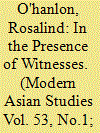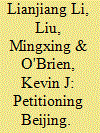| Srl | Item |
| 1 |
ID:
164870


|
|
|
|
|
| Summary/Abstract |
British observers of the nineteenth-century panchayat were convinced that it represented a judicial forum of great antiquity, in which petitioners were able to gain local and direct access to justice. They contrasted the panchayat favourably with the delays and frustrations that beset the eighteenth-century East India Company's attempts to channel all petitions through its own courts. This article examines the history of the pre-colonial panchayat in western India and its early modern predecessors. During the early modern centuries, a diverse array of state-level and local corporate bodies made up the landscape for the submission of petitions and the hearing of suits. Although many suits were local in nature, the process of hearing and adjudication itself gave these judicial spaces a significant ‘public’ dimension, and their forms of argumentation frequently invoked general principles of justice and moral order. From the early eighteenth century, the new form of the panchayat came to supersede these older corporate bodies and to reshape the forms of public that gathered around them. The Maratha state, based in Pune, sought firmer control over revenue and justice. State officials promoted the panchayat as a new type of judicial arena, weakening the local corporate institutions and tying them more closely to the Pune court.
|
|
|
|
|
|
|
|
|
|
|
|
|
|
|
|
| 2 |
ID:
114854


|
|
|
|
|
| Publication |
2012.
|
| Summary/Abstract |
What precipitated the 2003-06 "high tide" of petitioning Beijing and why did the tide wane? Interviews and archival sources suggest that a marked increase in petitioners coming to the capital was at least in part a response to encouraging signals that emerged when Hu Jintao and Wen Jiabao adopted a more populist leadership style. Because the presence of tens of thousands of petitioners helped expose policy failures of the previous leadership team, the Hu-Wen leadership appeared reasonably accommodating when petitioners arrived en masse in Beijing. Soon, however, the authorities shifted towards control and suppression, partly because frustrated petitioners employed disruptive tactics to draw attention from the Centre. In response to pressure from above, local authorities, especially county leaders, turned to coercion to contain assertive petitioners and used bribery to coax officials in the State Bureau of Letters and Visits to delete petition registrations. The high tide receded in late 2006 and was largely over by 2008. This article suggests that a high tide is more likely after a central leadership change, especially if a populist programme strikes a chord with the population and elite turnover augments confidence in the Centre and heightens expectations that it will be responsive to popular demands.
|
|
|
|
|
|
|
|
|
|
|
|
|
|
|
|